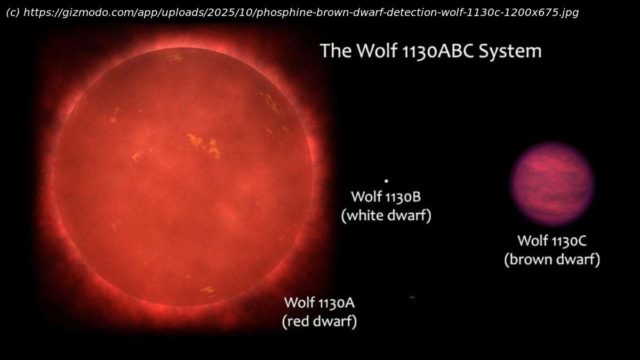The finding suggests phosphine—a possible biosignature—shouldn’t be viewed as evidence of alien life until natural, non-biological sources are ruled out.
For scientists, the urgent problem with phosphine—a molecule famously touted as a potential sign of life—isn’t so much about where it came from, but why it’s not where we think it should be. After a decade of searching, a long-awaited result has confirmed that our astronomical models aren’t a total bust. At least, for now.
In a Science paper published today, astronomers report the first-ever detection of strong phosphine signatures on a brown dwarf—a type of planet-star hybrid more massive than planets like Jupiter but not quite big enough to sustain the hydrogen fusion that powers stars. Prominent chemical models had long predicted that cosmic entities with gassy atmospheres would be rich in phosphine, but years of searching had turned up nearly nothing. The findings thus give closure to a problem that had plagued astronomers for at least a decade.
Just as importantly, the finding carries important implications for astrobiology. The phosphine detected on this brown dwarf, named Wolf 1130C, almost certainly formed through natural, abiotic processes. The challenge now is figuring out how an object like this could generate so much of it without life. Until researchers can explain that, any detection of phosphine—whether on a gas giant or a rocky planet like Venus—can’t be taken as a reliable sign of biology.
“The community has been waiting for this,” said Sara Seager, an MIT astrophysicist not involved in the new work. Seager co-authored a seminal paper from 2020 on the detection of phosphine on Venus. On Earth, phosphine mainly exists as the byproduct of anaerobic life, or creatures that thrive without oxygen. Because Venus’s chemical environment isn’t conducive to the natural formation of phosphine, the 2020 paper left astronomers wondering if the phosphine could have come from a life source—a biosignature.
“It is very refreshing—finally!” Nathalie Cabrol, research director at the SETI Institute’s Carl Sagan Center, added. Cabrol, also uninvolved in the new study, told Gizmodo in a video call that the paper presents “clear, plain” data of phosphine on the brown dwarf—just as models predicted.
Домой
United States
USA — software 'Failed Star' Mimics a Key Sign of Life, Complicating Our Search for...






